Photo

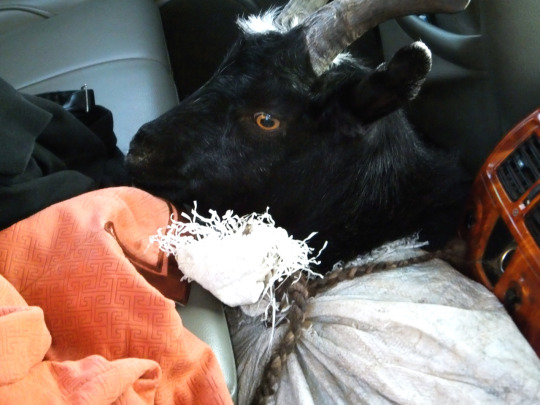



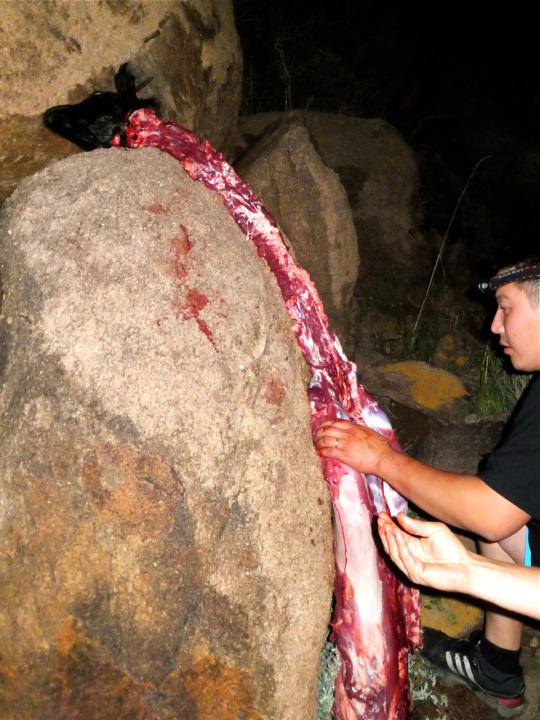


Warning: The following contains graphic material unsuitable for vegetarians, goat lovers, and those generally squeamish of blood and bones ;)
Boodog Day 1: Gutting the Goat
---------------
One goat, 12 handles of vodka, 2 cases of beer, 4 liters of airag, 1 sack of potatoes, 4 bunches of carrots, 10 jars of pickles, 6 tents, 5 Americans, 1 Pole, 1 Spaniard, 1 Kiwi, 1 Chilean, and 4 Mongolians piled into 2 jeeps and drove into the Gobi.
In the shadows of Baga Gazriin Chuluu, they set up camp, drank vodka, and slit the goat’s throat.
----------------
Oft have I dreamed of slaughtering and cooking whole my very own beast. In my fantasies, it is always a whole pig roasting over hot coals--studded with cloves, slathered in chili molasses, stuffed with apples.
Never could I have imagined that my first whole-animal cookout would be
A Mongolian boodog.
With a goat.
In the Gobi.
I could not have been chomping harder at the bit.
A boodog is a unique cooking method employed only on special occasions, as it is costly and preparation is intense. I feel, then and now, incredibly lucky to have shared such an experience.
As the organizer of this extraordinary camping trip, Corey had the honors of the kill. Armed with a small, sharp hunting knife, a swig of vodka, and some Mongolian advice, he plunged the blade to the hilt deep into the goat’s jugular and sliced it wide open. The animal--dumb and docile until this moment--jerked and struggled for its last breath, its death bleat ricocheting through the rock formations for miles. It gurgled as the blood, Vatican red and thick like molasses, seeped out onto the green grass. Ten seconds passed, and it was still and silent. The Mongolians nodded at Corey: it had been a good, clean kill.
Bayaraa took over. Stringing the goat up against a boulder, he set to skinning and deboning the animal. As he worked, Bayaraa told me that he came from a family of hunters and that the skills of preparing a boodog (among others) had been passed down from fathers to sons for generations. The deftness of his knife strokes left no room for doubt. Segment after segment of the goat was stripped to reveal the blood-fresh meat beneath.
The process is meticulous and lengthy: the entire animal is skinned but leaving the fur completely intact; all the meat is removed and chunked; and all the bones are extracted except for the legs. Essentially, what is left is a goat “sac” comprised of the intact fur from the neck down, which will be used as the cooking vessel.
As Bayaraa continued skinning and deboning, essentially turning the goat inside out, it began to look more and more like a strung-up giraffe. Out came the innards, thrown to one side for the wolves and vultures. Only the choice liver was saved for grilling. When the fur was finally, completely separated from the beast, the rest of the goat was broken down into piles: meat tidbits for kebabs, meat hunks for boodog, bones for broth, and bones for vermin.
The entire process took over two hours, and Bayaraa--bloodied to the elbows and happy with his work--wandered over to join the rest of us around the fire for goat kebabs and Mongolian vodka.
4 am found us finishing the last of the vodka and settling down for sleep. I drifted off to the hazy, happy thought that tomorrow we would do the boodog.
#Mongolia good eats#Mongolia cuisine#boodog#Mongolian boodog#goat roast#Baga Gazriin Chuluu#true Mongolian bbq#so you want to cook a whole animal#cooking a whole animal#we went camping in Mongolia and ate an entire goat
0 notes
Photo

Rousong & peanut butter: A model for Sino-American relations.
I still remember the day my best friend made me her special peanut butter & fried egg sandwich like it were yesterday. Ever since, I have been slathering that affable spread on anything and everything, sweet and savory. This late-night snack experiment, courtesy of Toast Box, was yet another resounding success.
Rousong (肉松) is one of the most ubiquitous Chinese food items and a prime example of the characteristic playfulness and humor of the cuisine. Literally translated, it means “loose meat” but is better known as “meat wool” or, even more specifically, “pork floss” (after all, pork is all but legislatively our national protein).
Rousong preceded the gastroscience craze by centuries, and even at the height of manipulated food mania, it stands as a food like no other. First stewed, then oven-evaporated, and finally wok-dried, the end product is a fluff with the consistency of raw cotton and the texture of cotton candy--sweet, salty porkiness that melts instantly upon the tongue.
It is a ubiquitous topping for a myriad of foods--congee, noodles, soups, tofu, soymilk--and is also a filling for buns and pastries. As a child, I used to eat rousong by the spoonful. As an adult, I confess I still steal spoonfuls of this irresistible pork cotton candy that ought to be a staple at every county and state fair.
Toast of rousong + PB = symbiotic culinary treaty: a double dose of sweet/savory duality and a trifecta of textures--creamy peanut butter, feathery rousong, crunchy bread.
If only Sino-American relations could be as simple and delicious.
#Chinese food#Sino-American relations#Toast Box#a model for Sino-American relations#an Anna O'Connor inspiration#culinary treaty#everything is better with peanut butter#everything is better with rousong#experiments at Toast Box#love of food#meat floss#meat wool#peanut butter#peanut butter & fried egg sandwich#peanut butter is the best#pork floss#pork sung#pork wool#rousong#try this toast!#why Chinese food is the best in the world#肉松#gastroscience
1 note
·
View note
Photo

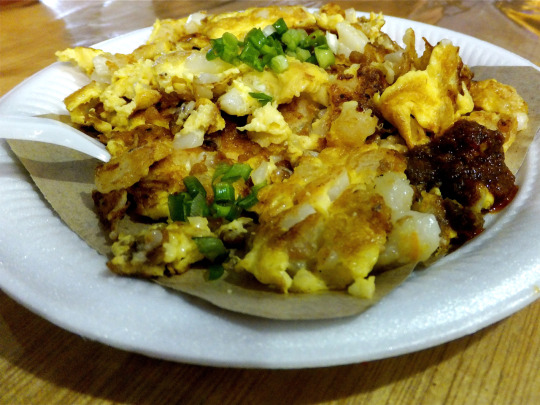

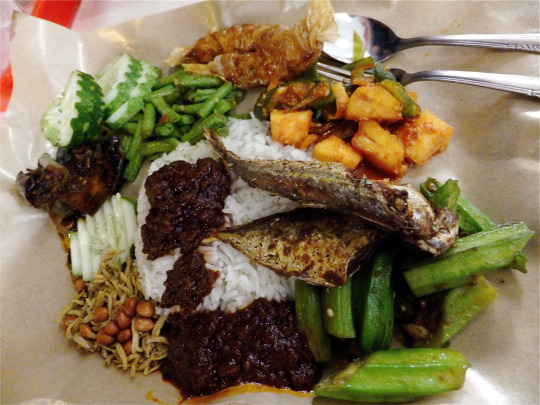

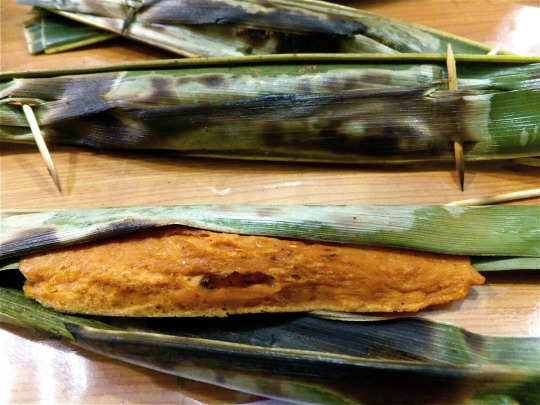



What better way to sample Singapore's culinary cornucopia than at the Singapore Food Festival?
#Malaysian breakfast#Singapore Food Festival#Singapore good eats#Singapore spring roll#breakfast in Malaysia#chai tow kwai#chilli crab#coconut curry soup#curry fish balls#curry laksa#don't eat in white#eating across Asia#giant grouper#good morning Malaysia!#laksa lemak#love of food#nasi lemak#otah-otah#otak#pork belly#pork rice#pork sticky rice#radish omelette#savory sticky rice#fried carrot cake
2 notes
·
View notes
Photo




Our first day in Singapore, we dropped off our luggage and promptly went on a quest for durian.
I first tasted the “king of fruits” in Beijing (summer 2009) and afterwards would occasionally seek it out in the Chinatowns of NYC. Durian is impossible to find outside southeast Asian enclaves, and even there, the fruit is not fresh. It is frozen for import/export and then thawed. This process invariably alters the texture of the fruit, and I was looking forward to experiencing fresh, unadulterated durian for the first time.
But to say that I “like” durian is not quite accurate…
Now, I am a very decisive person--quick to judge, confident in my assessments, unapologetic in my assertions--just ask my boyfriend. It drives him crazy.
My favorite color? Purple in autumn.
A living author I’d like to meet? Dorothy Allison in church.
The solution to government? Campaign. Finance. Reform.
Do not doubt my fleet-footed instinct for knowing what I like, dislike, feel, and think. But ask me if I like durian, and I become an acrobat on a wire of caveats.
Every bite is a surprise. (Step aside, box of chocolates.) Will it be almond custard or rotting onions? Will I ponder my palate in perplexed pleasure or scrunch my face in disgust? Every time I have a bad bite, I think, “that was the last,” and yet, somehow, this mysterious fruit compels me to return, unpredictable bite after unpredictable bite.
We smelled the durian stand from two blocks away, the aroma penetrating those formidable spiny husks to traipse down the street and tickle our noses. And when we stood in front of that wall of specimens, the fruit vendor chuckled at our awe. There must have been at least 20 cultivars on tap--a matrix of taste and texture.
We finally settled on a 2-kilo Maoshanwang (猫山王): the “Cat Mountain King” variety of the king of fruits. The vendor sat us at one of the tiny sidewalk tables in front of the stand, deftly cleaved the fruit open to bare its canary-yellow pulp, and left us to our business.
Never have I experienced a texture so custardy and so velvety, or a taste so truly indescribable. It was mildly sweet, buttery rich, tasting of a cornucopia of baking extracts: vanilla, almond, coconut, lemongrass, hazelnut. The fragrant aroma was so heady and overpowering it felt as though my taste buds had migrated to inside my nose.
Each mouthful waltzed across my palate to a unique rhythm, and each was delicious.
Over the next few days, I learned more about durian than perhaps I know about any other fruit.
I learned that there are hundreds of cultivars, each with its own distinct smell, taste, text, and code number starting with “D”; and that new cultivars are introduced and entered into horticulture competitions every year.
I learned that Singapore’s durian mania is insatiable--aficionados unfailingly gather every night to while away the evenings over a dank fruit or two.
I learned that it is prohibited in public buildings and hotels; that taxi drivers will insist you roll down your windows; that it is officially, legislatively banned from Singapore’s MRT (Mass Rapid Transit system of buses and trains).
I learned that durian burps smell like rotting yak carcass.
I learned that it is considered a “heaty” food, that is, a food siding with the “yang” (of yin-yang), capable of inducing sweating and raising blood pressure.
I learned to counteract this heat by pouring water into the empty shell and drinking it after consuming the fruit.
I learned that an overripe durian would ferment in the husk and that eating such a durian had the same effects as drinking a few beers.
I learned to not combine it with caffeine or alcohol.
I learned of its aphrodisiac qualities.
The night before we left Singapore, we went on a 2 am durian crawl. We started with a D 24 Sultan, thick, nutty, slightly bitter; then moved on to a D 159 Mon thong/Golden Pillow, super creamy, sweet, and mellow; finally ending with a D 188 MDUR78, acidic, tangy, and just starting to ferment.
The more we ate, the less we were inclined to cease. 4 am found me in a durian stupor--heart pounding, blood pressure spiking, death burps belching--my durian craving finally sated.
#durian#the king of fruits#Singapore good eats#eating in Singapore#love of food#eating across Asia#Maoshanwang#Cat Mountain King#猫山王#durian prohibited#Singapore MRT#aphrodisiacs#D 197#D 24#Sultan durian#D 159#Monthong durian#Golden Pillow durian#D 188#MDUR 78 durian#durian burps#to durian or not to durian
2 notes
·
View notes
Photo



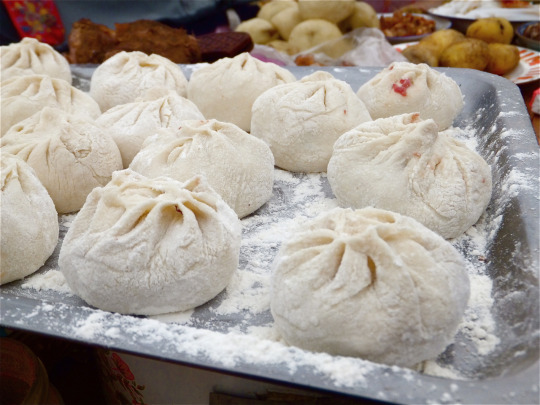
The Universal Language: Breaking Baozi in Tagong
“Xiao Meimei (little sister), come in and eat with us!” Jya Drolma beckoned me as I was returning from a late afternoon stroll in the hills. She herded me into the tent, sat me down, and handed me a cup of milk tea.
Today was the final day of the horse festival--a day reserved for feasting with family. For the past two days, friends, relatives, and backpackers alike slipped in and out of Jya Drolma’s family tent--in between games--nibbling on snacks and sipping copious amounts of milk tea. Today the tent felt empty yet intimate with just Jya’s husband, her brother and sister, and their respective spouses.
“Eat. EAT!” Jya’s sister shouted at me, pushing a hunk of braised yak into my hands.
I hesitated to accept. I felt that I had already partaken of more than my fair share of their hospitality, and I did not want to intrude upon this precious time with family. I remembered, too, when Jya had told me that they saved all year for this one feast--hoarding non-perishables and putting money aside--even traveling as far as Chengdu to procure certain special foods. (The table was heavy with flatbread, tsampa baozi, yak jerky, braised yak, smoked yak, smoked fish, pickled chicken feet, pickled vegetables, cold noodles, roasted nuts, sunflower seeds, dried fruit, fresh fruit, candy, jellies, cookies, biscuits, pastries, cakes, beer, wine…)
But Jya’s sister was a big lady with a booming voice and a bossy demeanor.
I took the meat.
As Jya fussed over me, rekindling the portable stove, I glanced around. The men smoked and played cards in the corner; Jya’s sister and sister-in-law cut and rolled dough for yak baozi; Jya’s husband, Gayla, finished mixing the minced yak filling and joined them to make the baozi--everyone chattering and laughing.
It reminded me of nights gathered around our kitchen table, making dumplings with my family. For the first time since embarking on our travels, I felt a pang of homesickness.
Jya lifted the lid of the gigantic pot to reveal tiers and tiers of steaming baozi, which she promptly began shoving into all available hands.
“Good?” asked her brother with a toothy grin.
“Good!” I echoed affirmatively.
“Eat, eat!!”
The extent of his Mandarin and my Tibetan thus exhausted, we grinned at each other between bites.
Here, away from home, where everything--customs, cuisine, language--is foreign and often unintelligible, the act of offering and accepting a shared meal is a humble dialogue universally understood.
Jya’s sister looked at me--a half-eaten tsampa baozi in my left hand, a steaming yak baozi in my right. She filled a plate to brimming with more yak meat, cold noodles, and pickled vegetables and plunked it down in front of me.
“Eat! EAT!!”
-----------
*When you get off the bus in Tagong, Jya Drolma likely will be there to greet you. Follow her to her guesthouse, tucked away behind the town’s main square (Jya Drolma and Gayla's Guesthouse, +86 28 8555 3856). Theirs is easily the most wonderful and most beautiful establishment in town.
And when you see Jya, please tell her Xiao Meimei misses her.
#Chinese food#Sichuan#Tagong#Tagong eats#Tagong horse festival#Tibet#breaking baozi in tagong#food that binds#love of food#on the Tibetan Plateau#the universal language#together we eat#tsampa baozi#yak baozi#牦牛肉包子#guesthouses in Tagong#guesthouses on the Tibetan Plateau#Jya Drolma and Gayla's Guesthouse#the best guesthouse in Tagong
0 notes
Photo

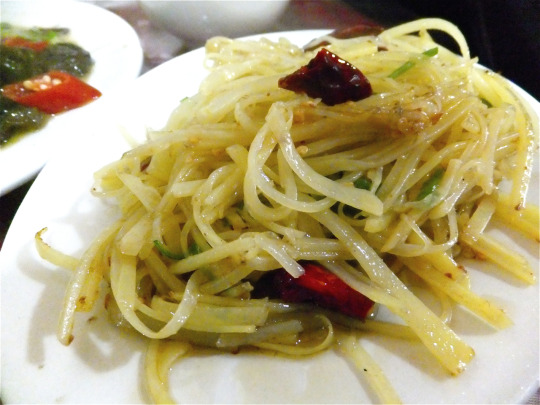
Yet another reason why Chinese food is the BEST cuisine in the world is that it is deeply rooted in wit, puns, and illusions—a culinary magic show to tease and tantalize all the senses.
A dish can be playful and coy--its aroma, presentation, taste, and texture colluding to masquerade and surprise. Even the name of a dish can be a carefully crafted riddle.
Having eaten nothing but yak products and tsampa for the past two days, we went in search of vegetarian Chinese food and stumbled upon a hole-in-the-wall run by a husband and wife team from Anhui province (you know how I adore such establishments).
“The word on the street is that you make an amazing eggplant dish.”
“Ah, you must be talking about our yuxiang qiezi,” she said, reaching into the vegetable bin and coming up with two long eggplants, a head of garlic, a bunch of cilantro, and a handful of chilies, red and green. Without breaking our gaze, she began slicing and chopping, the movements of her heavy cleaver sure and swift. Such knife skills were very promising. We rounded out with an order of tudousi (a Guo family favorite)* and waited.
This husband-and-wife team was a well-oiled machine. When she had finished all the prep work he fired up the wok, which was soon snap-crackle-popping away, wafting heavenly and mysterious aromas. I wasn’t familiar with yuxiang qiezi and did not know what to expect beyond something eggplant-based that smelled increasingly amazing.
The dishes arrived on the table, and I stared down at the yuxiang qiezi, my quizzical expression reflected in the slick, glistening surface. It was a mush…albeit festive with red and green chilies.
The first bite was velvety soft, tangy, spicy, sweet…and fishy?! I crinkled my nose, focused, and tried again.
And then, then I saw behind the magic curtain. Yuxiang qiezi (鱼香茄子) translates into “fish essence eggplant,” that is, the eggplant is meant to imitate fish!!
The pieces now all fell into place--the minced eggplant flash-fried and then sautéed to the texture of fish flesh; the fish sauce, yellow wine, and vinegar gravy for essence of fish; the dish served in a fish-shaped platter--the result greater than the sum of all its clever, clever parts.
My enlightened third bite was unequivocally delicious.
----------
*Tudousi (土豆丝), or matchstick potatoes, is a simple sauté of julienned potatoes often with green peppers, red chilies, and Sichuan peppercorns. Decades ago when my father was a rookie professor, he delighted in preparing this dish for departmental potlucks to befuddle his colleagues who could not believe that the matchsticks were actually hand-cut potatoes. These days, it’s become a bit of a tradition to speculate over the Guo mystery dish.
#Chinese food#love of food#why Chinese food is the best in the world#Guo family eats#yuxiang qiezi#fish essence eggplant#鱼香茄子#matchstick potatoes#土豆丝#what are you eating?#culinary magic#food with wit
0 notes
Photo



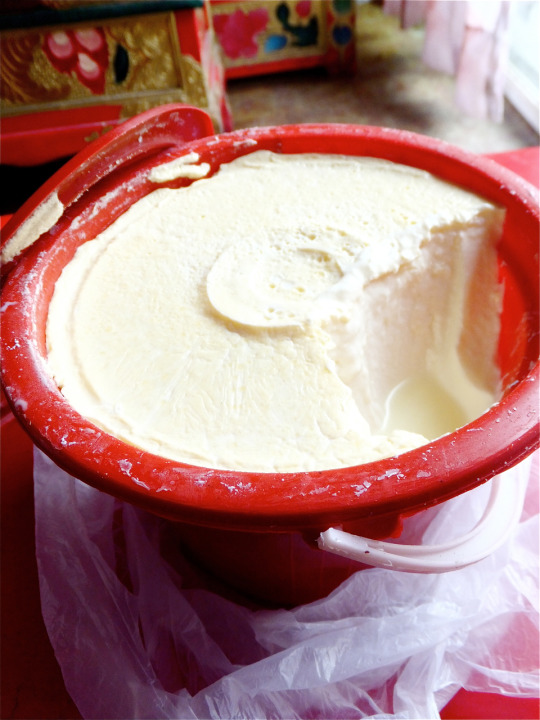
As expected, Tibetan food is not diverse. Little grows at such altitude, and staples consist mainly of yak products--meat, milk, cheese, yogurt--and tsampa, flour milled from roasted barley. Thus, one day was more than sufficient to sample the traditional staples.
Tsampa (རྩམ་པ་) preparation is quite simple: mix barley flour with leftover butter tea and form into bite-size patties. The result is a nutty little nugget that makes for a damn good breakfast.
Yak meat is boiled and boring, but the dry spice mix for dipping is quite feisty.
Butter tea (po cha བོད་ཇ་) is straight. up. unpalatable. Heed my words, or you will be sorry...unless you happen to enjoy drinking melted, salted yak butter by the bowlful...which Tibetans seem to do every day...on the quarter hour...
Yak yogurt is like a magical unicorn. Crack the top layer of pure butter and dip into thick, tangy, creamy, yaky, milky deliciousness--it's better than Fage. *GASP* A gallon bucket goes for 25 RMB and delivers three days of yogurt rapture.
So, is it any wonder that Tibetans are twice the size of any Han Chinese?
#Tibetan cuisine#Tibetan staples#Tsampa#རྩམ་པ་#Yak meat#Yak yogurt#Butter tea#Suyoucha#po cha#བོད་ཇ་#unicorn foods#for the love of yak yogurt
14 notes
·
View notes
Quote
Jack Stepney had once said of her that she was as reliable as roast mutton. His own taste was in the line of less solid and more highly seasoned diet, but hunger makes any fare palatable, and there had been times when Stepney had been reduced to a crust.
House of Mirth, Edith Wharton
Was there ever such a writer? There was but she.
0 notes
Photo
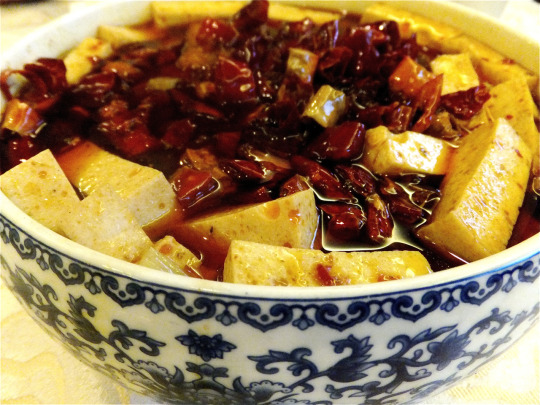
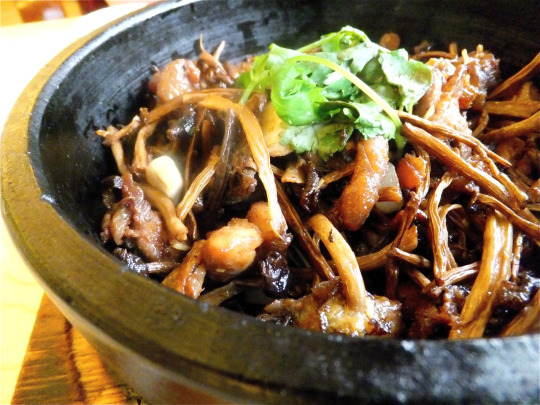


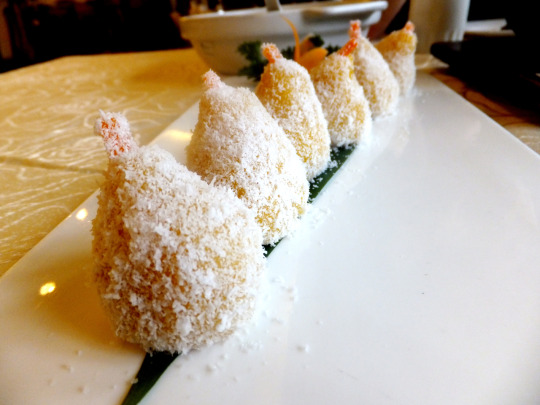


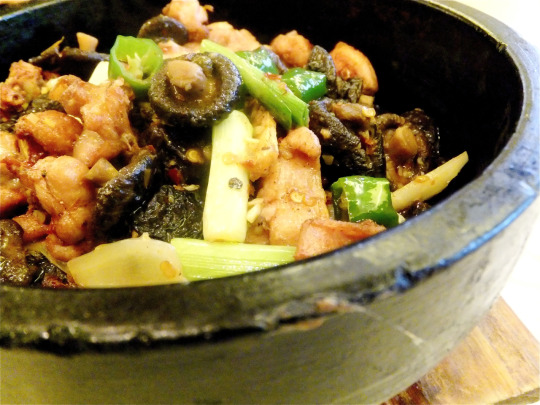
As I've asserted before, I'm more of a cozy, hole-in-the-wall, “it’s my secret” kind of food seeker, but the restaurant near our hostel in Chengdu really hit the mark on fine(r) dining. Not only did it offer a diverse and sophisticated menu, an attention to presentation, and a well-maintained and peaceful atmosphere, it advocated for healthy, restorative cooking. Each dish was carefully prepared with traditional Chinese herbs and medicinal foods for a yin-yang balance: soups with rich broths and goji berries and lotus bulbs, sautées with wood mushrooms balanced with dried chilies, jellies with ginseng and teas.
We could have prowled the streets in search of that next secret hole-in-the-wall, but with such delicious nourishment just around the corner, we found our feet and stomachs pointing in the same direction day after day.
#Chengdu good eats#love of food#Chinese food#why Chinese food is the best in the world#for the love of jellies
2 notes
·
View notes
Photo


*The following piece contains language unsuitable for children.
There wasn’t anything that I really wanted to see or do in Chongqing (重庆)—the global capitol of smog, rain, and humidity, of skyscrapers, cranes erecting new skyscrapers, and old hutongs being torn down to make way for future skyscrapers. However, this is home to the infamous Chongqing ma la huoguo (重庆麻辣火锅), a fiery variation of hot pot that we had been anticipating for days.
So here’s the thing. I LOVE hot pot (huo guo 火锅). It’s fresh, it’s fun, and it’s fucking delicious.
When I was ten years old, my Laolao (姥姥)—my maternal grandmother—came to live with us in Wisconsin for six months. One of my most vivid memories of that visit was the night she prepared a hot pot feast. A flavorful chicken broth simmered with peppercorns and ginger and scallions into which we dipped paper-thin slices of lamb, whole prawns, chunks of tofu, oyster mushrooms, bean sprouts, baby bok choy, sliced turnips, chunks of taro, Chinese cabbage, and vermicelli noodles, swirling them around in the bubbling stock until done and then dipping them in a savory sesame sauce garnished with cilantro and chili to taste. That sesame sauce was the best I had ever tasted, and I remember the adorable smirk of pride on Laolao’s face as she told me the secret: “You must have chive flower paste (jiu cai hua jiang 韭菜花酱); this is the secret to the best sesame sauce. Isn’t it delicious?”
Hot pot is a meal of boundless potential—an infinite matrix of base broths, ingredients to be cooked, and dipping sauces—therefore, I expect a lot of from it. After all, I am Chinese.
Our base stock arrived: a vat of bubbling oil with at least a kilo each of simmering red chilies and Sichuan peppercorns (hua jiao 花椒)—the source of the mala (literally “numbing and spicy”) sensation. It looked sensational and lethal, like a hot brunette in a tight, full-body leather dress. Our uncooked ingredients arrived next. It was time to see what the buzz was all about: we plopped a third of the ingredients into the bubbling mala waves and waited.
The shrimp were the first to cook through, and it was with hungry anticipation that I chopsticked one out. That first bite left my mouth so dismayed that it took me a few moments to register my confusion for the disappointment that it really was. I was expecting the 4th of July, but that shrimp was like a defective sparkler; the flaccidity of its heat was straight up shameful.
To add insult to injury, it was completely devoid of any “shrimpyness” or, frankly, of any flavor at all, as my taste buds were taken hostage by the numbing sensation of the Sichuan peppercorns. I had not counted on this food expedition to conjure flashbacks to my wisdom teeth extractions.
Thus anesthetized, we worked our way through the remainder of the ingredients. I could have thrown in my dirty socks and not have known the difference. As we ate, I felt as though I had been punked by the entire foodie universe.
Chongqing hotpot is. NOT. SPICY. Whoever tells you otherwise is either a Scoville pussy or has never eaten a proper chili. To the former, my condolences; to the latter, come over for some habañero chutney and then tell me what spicy is.
The sensation of having your entire nasal and mouth cavity numbed by Sichuan peppercorns is totally antithetical to enjoying good food. What’s the fucking point? You can’t taste a damn thing.
Hot pot is inherently a very healthy meal. Chongqing hot pot, not so much. Essentially, you are deep fat frying everything and then dunking it all into the dipping sauce of…wait for it…straight. up. sesame. oil.
I just don’t get it. Is it a challenge? Do people wake up in the morning thinking, “Wouldn’t it be fun to see how much mala I can handle today? It’s like botox, with shorter-term effects. Weeee!” I guess I’m just not that sort of foodie. I enjoy eating. I enjoy whetting my tongue with nuanced and playful flavors, not clubbing it over the head like a baby seal.
Chongqing hot pot could have been new and delicious. With a different base stock, a mixture of different chilis, a more delicate addition of Sichuan peppercorns, and a more interesting dipping sauce, it could be a dish worthy of all the hype. Could.
#Chongqing hot pot#hot pot#the great hot pot disappointment#火锅#重庆火锅#麻辣#so what are the pros for Chonqing?
4 notes
·
View notes
Photo



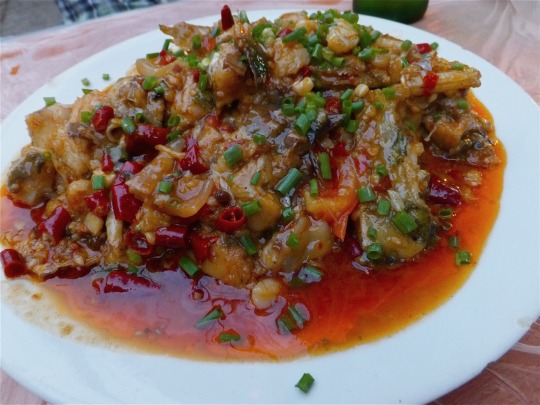
The fact of the matter is that one cannot truly experience the full girth and potential of Chinese cuisine if one is not willing to precipitously lower expectations of hygiene. Sure, it’s risky but absolutely worthwhile and necessary as far as this little piggy is concerned.
But let’s not sugarcoat things: 95% of the eating establishments in China would bomb health code inspection, and of the remaining 5%, probably 4.5% would barely eke by with a passing D grade. If you don’t want to be stuck eating at the most expensive hotel restaurants that are most likely catering to Western tourists and business deals, you have to adjust.
Generally, my standards for kitchen cleanliness are pretty damn high. I wash produce thoroughly; I segregate meat cutting boards; I wash dishes as I’m cooking; I always have a counter rag ready at hand; and quite frankly, sitting down to eat before the entire kitchen is clean often gives me anxiety. But in China, I can turn a blind eye to dingy little hole-in-the-walls with filthy floors and strewn with garbage; to eat off dishes and utensils barely rinsed with water potentially teeming with parasites; to accept food from hands (especially fingernails) jet black with dirt. I tell myself, I’m only seeing a portion of the picture, and while it’s likely that my food is being prepared under stomach-curdling circumstances, then again, it is possible that it’s not. It’s mind over matter, and my powers of delusion are capable of incredible heights of oblivion and amnesia.
But what can I do when the fish I have just hand-picked for dinner is then swiftly scooped out of the tank and smashed to its death in the. street. gutter in one seamless motion. Do I allow myself to register the accumulated filth—the garbage, the dirt, the various bodily secretions—that are surely washing over the now listless flesh that was so fresh just seconds before, that I am expected to now consume? How can I possibly forget them? Do I object when the cook’s version of “thoroughly washing my fish” (which he promised upon seeing my irrepressible exclamation of horror) is to fetch it from the. street. gutter and swish it around in a big tub of what looks to be dish-washing water?! My eyes burned with the sequence of images that could not be forgotten, and my stomach trembled in fear.
My head hadn’t even completed its first reel before the fish was “cleaned” and gutted and chopped. It was too late now; this gutter fish was ours for the keeping. There was one last hope: Could I convince myself that the pilgrimage of a flash-fry in a screaming hot wok of bubbling oil could cleanse the flesh?
It emerged from the wok—steaming, fragrant, swimming with bright chilies. My eyes drowned in the vibrant colors and glistening sauce that winked at me flirtatiously; my nose inhaled deeply the ticking aromas of sweet, sour, spicy, and salty heavy with promise; my mouth instinctively began to salivate, and I mechanically put my chopsticks in motion.
The first bite was truly incredible, and while the life, death, and rebirth of this gutter fish could not be successfully stricken from memory, it was transformed from one of trepidation and horror to one of comedy.
Thus emboldened, I plunge fearlessly forward with chopsticks aloft and mouth agape.
#Chinese food#love of food#eating across China#gutter fish#the rapid deterioration of my hygiene standards#how dirty is too dirty?#adjusting to food on the road
2 notes
·
View notes
Photo

These little piggies ran into Hannibal Lecter. Poor little porkers.
1 note
·
View note
Photo




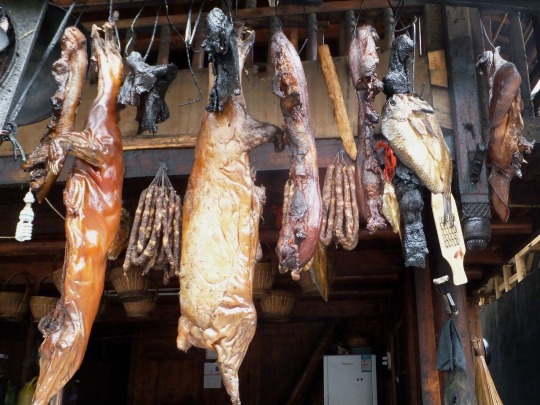
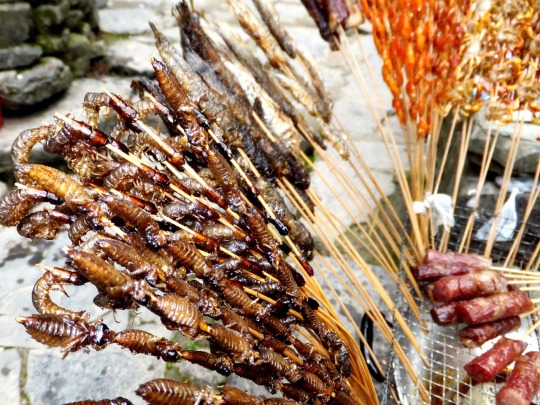

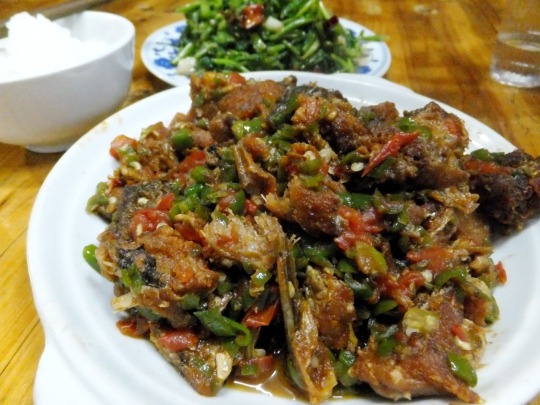


It is a truth universally acknowledged that this little piggy of great appetite must be hot on the scent of good food.
#Dehang good eats#love of food#Chinese food#why Chinese food is the best in the world#德夯#Hmong good eats#Miao good eats#crab skewers#larou#腊肉#sauteed smoked pork belly#Miao food#Hmong food#smokehouse#water bug skewers#苗鱼#苗酒#Miao fish#Miao liquor#Miao chicken#土鸡#breakfast noodles
5 notes
·
View notes
Photo


The stretch of road that leads up to the base of Huashan is lined with alternating restaurants, shops, and bodegas, each storefront seemingly identical to others of its kind. Trying to pick one is really just luck of the draw, and our first night at Huashan, we hit the jackpot.
As we wandered aimlessly down the stretch at dusk passing restaurant after restaurant, catcalls abounded from indolent front-of-the-house employees with vacant, ambivalent eyes and feeble, insincere promises. You can imagine how tempted we were. Halfway down the road, we were approached by yet another restaurateur: “Please to come and take a look at menu.” Our bodies were already, instinctively turned away in the direction of “No, thank you,” but there was something about his manner that swiveled us around.
Perhaps it was his friendly smile and casual air; perhaps it was his explicit invitation to take a look at the menu rather than to eat; perhaps it was his sitting down with us to go over the menu together or his recommendation of local dishes that were his favorites, rather than the most expensive items. Certainly, it was all these intimate, unassuming, earnest touches.
As it turned out, he ran the restaurant with his wife who turned out to be just as lovely as he. He ran the front; she cooked the food, and so when we finally decided on some wild Huashan greens (Huashan yecai 华山野菜), cornmeal congee, and a simple chicken dish, she was the one to consult with us on the finishing touches—how spicy, how garlicky, how oily (very, very, just enough, thank you!).
While we waited for the food, he brought us cold beers and hot tea and chatted with us about our impending hike the following day, offering tips and encouragement.
The food was simply perfect: animated flavors, toothsome textures, vibrant colors. We promised to return post-hike for a rabbit dinner, which they had both recommended.
…And so we did, on wobbly knees and jellyfish legs. The local greens were good enough to repeat, and the braised rabbit was just as delicious as it looks.
Yixiang Fandian (溢香饭店) turned out to be one of those cozy, hole-in-the-wall, “it’s my secret” finds that is the ultimate thrill for every food seeker, and this little piggy will not soon forget such a diamond in the rough.
#Chinese food#love of food#I climbed Huashan give me my rabbit reward!#why Chinese food is the best in the world#Yixiang Fandian#溢香饭店#Huashan good eats#rabbit reward#wild Huashan greens
0 notes
Photo
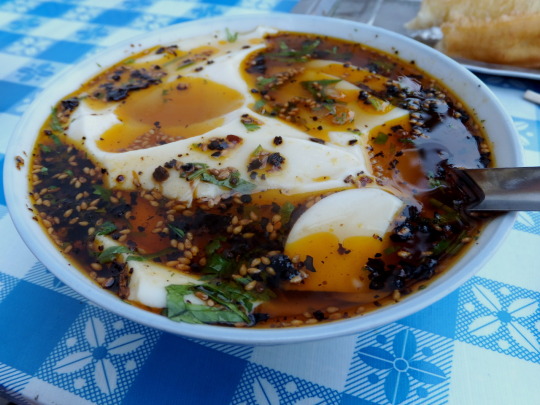


One of the infinite reasons why I think Chinese food is the BEST cuisine in the world (I promise, this forthcoming post will never ever have an end...) is that it is, as far as my experience, knowledge, and research goes, the. most. diverse. cuisine in the world.
Recall our Breakfast(s) of Champions in Xi'an: that doufu nao (豆腐脑) consisted of silken tofu flash-steamed in individual cups, then doused in a dark soy broth, and finally garnished with pickled turnips and soy beans, chili, and cilantro.
At Huashan, 120 kilometers to the east, the doufu nao is gently steamed in 60-quart pots, then spooned up and floated in a 50/50 mix of dark soy/sesame oil, and finally garnished with toasted sesame seeds, dried seaweed and chili, and cilantro.
Such a simple, ubiquitous dish, yet such regional diversity within the matrix of doufu nao accoutrements. I look forward to my next bowl, and the one that follows, and the one after that (but I probably won't post about all of them :)
*The match-up of Xi'an youtiao (油条) versus Huashan youtiao was a solid draw, but does one ever tire of photos of sensually sizzling fried dough? Right.
#Chinese breakfast#Chinese cruellers#Chinese food#breakfast of champions#doufu nao#love of food#now I can climb Huashan#silken tofu#youtiao#油条#豆腐脑#why Chinese food is the best cuisine in the world
2 notes
·
View notes
Photo
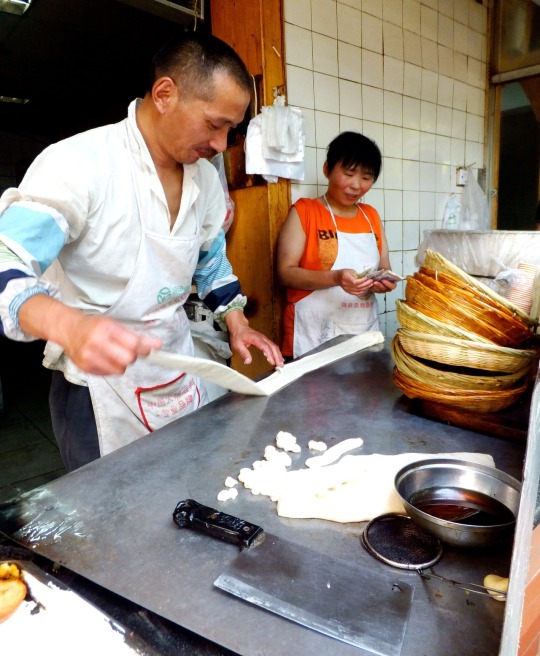
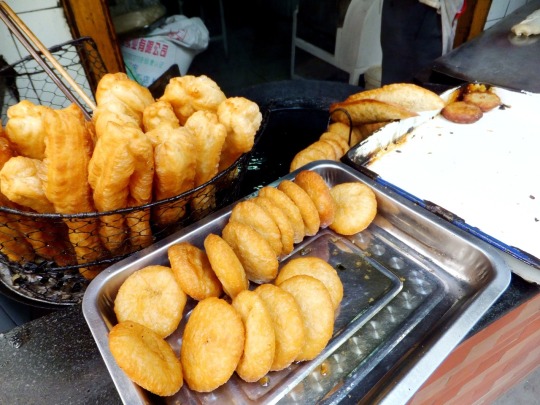
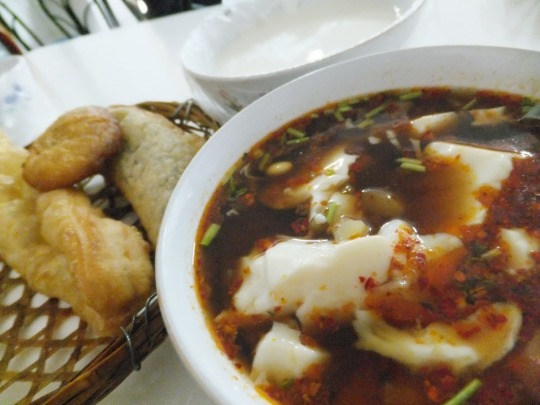
This husband and wife team--add equal parts shyness and kindness, shake, and serve--manned a little hole-in-the-wall joint around the corner from our hostel serving the most common (as in everyday-basic and humbly-comforting) Chinese fare. The kind of hole-in-the-wall joint where old pensioners gather for gossip over breakfast; where cabbies congregate for a bowl of noodles that hits the sweet spot of authentic, quick, and cheap; where 9-5'ers stop on their way home to pick up a bag of hearty, rejuvenating soup; and where we ate breakfast everyday in Xi'an.
Sure, we could have trolled the city to diversify our meals, but when I stumble across a neighborhood gem serving up the quintessential Chinese breakfast--the breakfast I ate with my grandparents as a child--I'm not one to look a gift horse in the mouth.
Day One: They graciously acquiesced to letting me stick my camera in their faces and my nose into their vats of soy milk.
Day Two: They remembered without prompting to give us extra garnishes on the side and that I took just one spoonful of sugar in my soy milk and Meir none.
Day Three: They waved the change on the total and gave us an 8% discount.
So for three days we ate the Breakfast of Champions:
Youtiao (油条): freshly fried dough strips dripping oil from the wok
Doufu nao (豆腐脑): silken tofu in a soy broth garnished with pickled veggies, chili, and cilantro
Soy milk (豆漿): with or without sugar
If I'm ever back in Xi'an, you know where to find me for breakfast.
#Chinese breakfast#Chinese food#Xi'an eats#breakfast of champions#doufu nao#eating in Xi'an#love of food#youtiao#zhagao#油条#炸糕#豆腐脑
2 notes
·
View notes
Photo


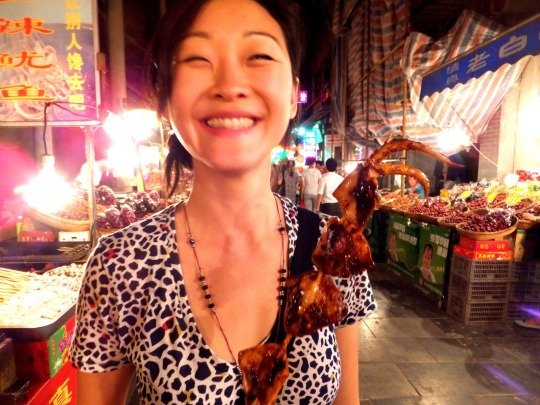


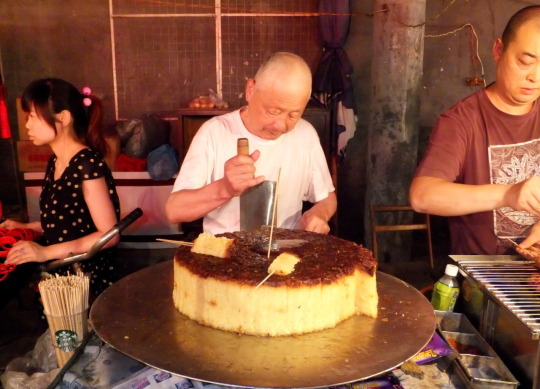


Xi'an serves anything and everything in popsicle form. Skewered us silly.
#eating in Xi'an#Chinese food#Xi'an eats#Muslim Quarter#love of food#street food#everything on a stick#you can skewer anything#eating in the Muslim Quarter#tourist in Xi'an#Xi'an street food#lamb skewers#pig trotters#Xi'an calamari#calamari skewers#happy claw#corn on a skewer#egg lollipops#quail eggs#sticky rice cake#Xi'an tempura
3 notes
·
View notes